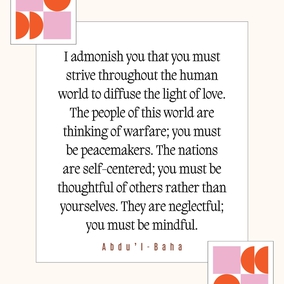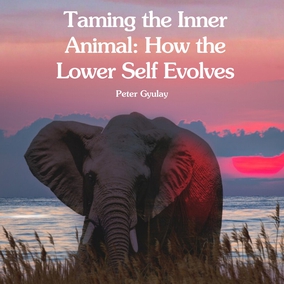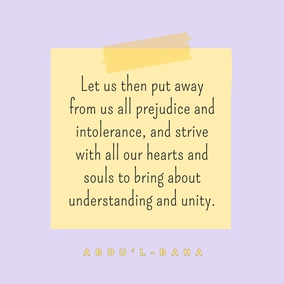The views expressed in our content reflect individual perspectives and do not represent the authoritative views of the Baha'i Faith.
In Parts 1 and 2, we offered this simple method for “figuring out prophecy”:
Step 1: If impossible, then not literal.
Why is the literal reading not possible here?
(Appeal to absurdity.)
Step 2: If not literal, then figurative.
What is the comparison or analogy expressed here?
(Show what’s being compared.)
Step 3: If figurative, then symbolic.
What qualities does this symbol represent?
(List key attributes suggested by this symbol.)
Step 4: If symbolic, then spiritual and social.
Who (or what) represents those qualities?
(Apply to historical person(s) and/or event(s).)
The earth altogether shall be His handful on the Day of Resurrection, and the heavens shall be rolled up in His right hand. Glory be to Him! High be He exalted above that they associate! — Qur’an 39:67 (Arberry’s translation.)
These “Four Steps” to “figuring out” prophecy (i.e. interpreting prophecy figuratively, instead of literally) can be used both to analyze certain examples of Baha’i interpretation of prophecy, as well as to independently analyze prophecy on one’s own. To interpret prophecy, it is helpful to look at how prophecy has been interpreted by those gifted in the art of interpretation. Baha’is believe that Baha’u’llah is gifted in interpreting prophecy by divine inspiration (i.e. by “revelation”).
Here, we can analyze Baha’u’llah’s interpretation by means of these four steps, even though Baha’u’llah is independently interpreting this verse by way of revelation. We will take the liberty of applying each of the four steps where they best make sense.
Baha’u’llah’s most important interpretive work is called the Kitab-i-Iqan (The Book of Certitude), revealed in January 1861 (in just two days and two nights) in Baghdad. In the following passage, Baha’u’llah begins to interpret Qur’an 39:67, starting with what we will identify as “Step 1”:
Step 1: If impossible, then not literal.
Why is the literal reading not possible here?
(Appeal to absurdity.)
And now, comprehend the meaning of this verse: “The whole earth shall on the Resurrection Day be but His handful, and in His right hand shall the heavens be folded together. Praise be to Him! and high be He uplifted above the partners they join with him!” And now, be fair in thy judgment. Were this verse to have the meaning which men suppose it to have, of what profit, one may ask, could it be to man? Moreover, it is evident and manifest that no such hand as could be seen by human eye could accomplish such deeds, or could possibly be ascribed to the exalted Essence of the one true God. Nay, to acknowledge such a thing is naught but sheer blasphemy, an utter perversion of the truth. And should it be supposed that by this verse are meant the Manifestations of God, Who will be called upon, on the Day of Judgment, to perform such deeds, this too seemeth far from the truth, and is surely of no profit. – Baha’u’llah, The Book of Certitude, pp. 47–48.
Here, by posing a key rhetorical question (“Were this verse to have the meaning which men suppose it to have, of what profit, one may ask, could it be to man?”), Baha’u’llah leaves it up to the reader to come up with the right answer. This is an effective “Socratic method,” allowing the reader to independently “discover” the answer, whereby the reader makes explicit what Baha’u’llah has already made implicit. Baha’u’llah moreover, by employing this didactic method, interactively engages the reader and guides the reader in making the transition from literal meaning to figurative meaning.
Step 2: If not literal, then figurative.
What is the comparison or analogy expressed here?
(Show what’s being compared.)
Here, Step 2 is implicit. Baha’u’llah is about to draw an analogy between physical and spiritual worlds of experience, i.e. the correspondence between physical “earth” and spiritual “earth.” In other words, having ruled out a literal, i.e. physical, interpretation, the figurative interpretation is a spiritual interpretation. Then, in the Epilogue (after Step 4 , below), Baha’u’llah then makes Step 2 explicit. What Baha’u’llah leaves unstated as implicit, elsewhere, Abdul-Baha makes explicit:
The human spirit is an intellectual, not sensible reality. In explaining these intellectual realities, one is obliged to express them by sensible figures because in exterior existence there is nothing that is not material. . . . For example, grief and happiness are intellectual things; when you wish to express those spiritual qualities you say: “My heart is oppressed; my heart is dilated,” though the heart of man is neither oppressed nor dilated. This is an intellectual or spiritual state, to explain which you are obliged to have recourse to sensible figures. . . . For example, it is a Persian and Arabic expression to say that the earth was asleep, and the spring came, and it awoke; or the earth was dead, and the spring came, and it revived. These expressions are metaphors, allegories, mystic explanations in the world of signification. – Abdu’l-Baha, Some Answered Questions, pp. 84–85.
Step 3: If figurative, then symbolic.
What qualities does this symbol represent?
(List key attributes suggested by this symbol.)
On the contrary, by the term “earth” is meant the earth of understanding and knowledge, and by “heavens” the heavens of divine Revelation. Reflect thou, how, in one hand, He hath, by His mighty grasp, turned the earth of knowledge and understanding, previously unfolded, into a mere handful, and, on the other, spread out a new and highly exalted earth in the hearts of men, thus causing the freshest and loveliest blossoms, and the mightiest and loftiest trees to spring forth from the illumined bosom of man. – Baha’u’llah, The Book of Certitude, p. 48.
Here, Baha’u’llah evokes the inner landscape of mind and heart, inhabited by the spirit, the inner person — the real “you” and “me.” Spiritual “life is like a dream” — except it’s real. It’s here — in the enchanted garden of your soul — that “the freshest and loveliest blossoms, and the mightiest and loftiest trees” may “spring forth.” These are spiritual realities, expressed metaphorically, in physical images.
Step 4: If symbolic, then spiritual and social.
Who (or what) represents those qualities?
(Apply to historical person(s) and/or event(s).)
The last step is applying the prophecy to history, whether past or present, in which the meaning of the prophecy finds its actual fulfillment. Here, Baha’u’llah offers a general interpretation, rather than a specific one, by comparing “Dispensations of the past” (i.e. past Messengers of God and their teachings and laws) as spiritual worlds unto themselves:
In like manner, reflect how the elevated heavens of the Dispensations of the past have, in the right hand of power, been folded together, how the heavens of divine Revelation have been raised by the command of God, and been adorned by the sun, the moon, and stars of His wondrous commandments. Such are the mysteries of the Word of God, which have been unveiled and made manifest, that haply thou mayest apprehend the morning light of divine guidance, mayest quench, by the power of reliance and renunciation, the lamp of idle fancy, of vain imaginings, of hesitation, and doubt, and mayest kindle, in the inmost chamber of thine heart, the new-born light of divine knowledge and certitude. – Baha’u’llah, The Book of Certitude, pp. 48–49.
Epilogue:
Finally, Baha’u’llah makes Step 2 explicit, by telling the reader that this verse from the Qur’an (Q. 39:67) contains figurative (“abstruse allusions”) and symbolic discourse (“symbolic terms”)—and what the purpose of this discourse is:
Know verily that the purpose underlying all these symbolic terms and abstruse allusions, which emanate from the Revealers of God’s holy Cause, hath been to test and prove the peoples of the world; that thereby the earth of the pure and illuminated hearts may be known from the perishable and barren soil. From time immemorial such hath been the way of God amidst His creatures, and to this testify the records of the sacred books. – Baha’u’llah, The Book of Certitude, p. 49.
Since Baha’u’llah has already interpreted Qur’an 39:67, there is now no need to “show what’s being compared.”
















Comments
Sign in or create an account
Continue with Googleor